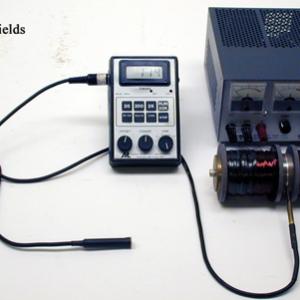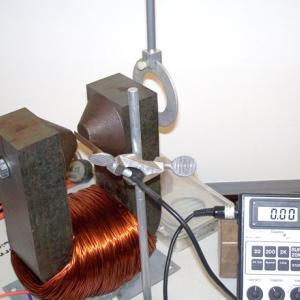College of Liberal Arts & Sciences
5H10.55 - Gaussmeters
The Gaussmeters are used to measure magnetic fields and their strengths. The axial probe is used to measure inside coils as the Hall Effect chip used in the probes need to be perpendicular to the magnetic field for measurements to take place. The ELF meter is used generally for measuring the magnetic fields associated with AC power lines and electrical motors and other electrical devices.
Insert the Gaussmeter probe between the poles of an electromagnet. Turn on the electromagnet and see just how powerful your electromagnet is.
- Joshua A. H. Littleton and Richard Secco, "An Indoor Magnetic Exploration Survey", TPT, Vol. 56, #8, Nov. 2018, p. 544.
- Chih-Ta Chia and Ya-Fan Wang. "The Magnetic Field Along the Axis of a Long Finite Solenoid", TPT, Vol. 40, # 5, p. 288, May 2002.
- Martin Connors, "Measurement and Analysis of the Field of Disk Magnets", TPT, Vol. 40, # 5, p. 308, May 2002.
- J. L. Sandoval, A. Porta, and P. Segarra, "Measuring Magnetic Force and Magnetic Field of Small Permanent Magnets", TPT, Vol. 28, # 2, Feb. 1990, p. 124.
- Paul A. Bender. "Measuring Magnetic Fields With an IC Chip in the Introductory Lab", AJP, 89, Vol. 54, # 1, January 1986.
- Thomas B. Gabrielson, "Oatmeal-Box Magnetometer", Apparatus for Teaching Physics, p. 178, Edited by Karl Mamola.
- B. D. Sukheeja, D. K. Kohli, "Charge Amplifier Type of Flux Meter", Apparatus for Teaching Physics, p. 180, Edited by Karl Mamola.
- Curt Suplee, "Magnetism and our lives", Everyday Science Explained, National Geographic, p. 84.
Disclaimer: These demonstrations are provided only for illustrative use by persons affiliated with The University of Iowa and only under the direction of a trained instructor or physicist. The University of Iowa is not responsible for demonstrations performed by those using their own equipment or who choose to use this reference material for their own purpose. The demonstrations included here are within the public domain and can be found in materials contained in libraries, bookstores, and through electronic sources. Performing all or any portion of any of these demonstrations, with or without revisions not depicted here entails inherent risks. These risks include, without limitation, bodily injury (and possibly death), including risks to health that may be temporary or permanent and that may exacerbate a pre-existing medical condition; and property loss or damage. Anyone performing any part of these demonstrations, even with revisions, knowingly and voluntarily assumes all risks associated with them.


